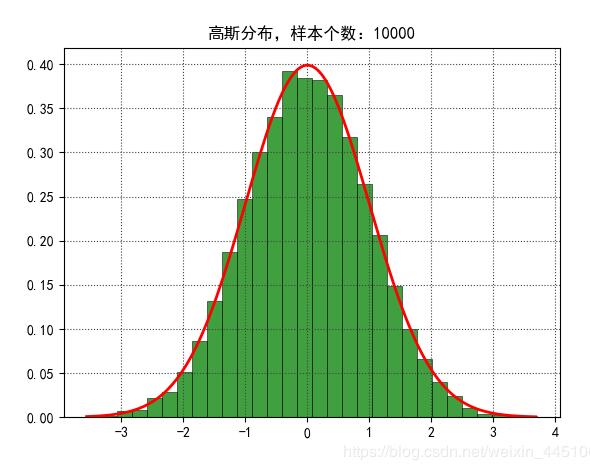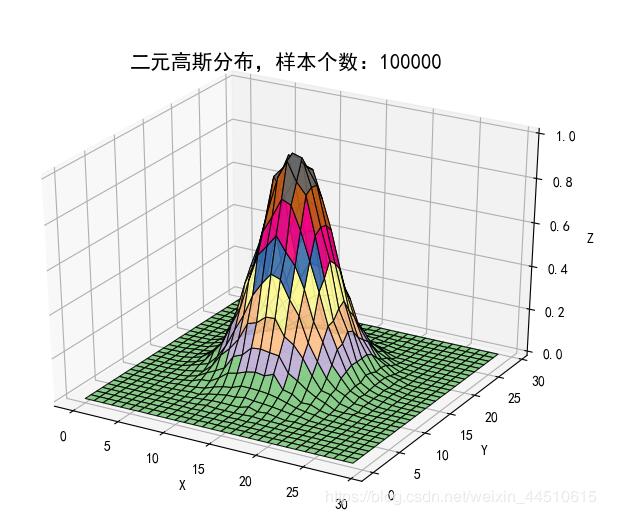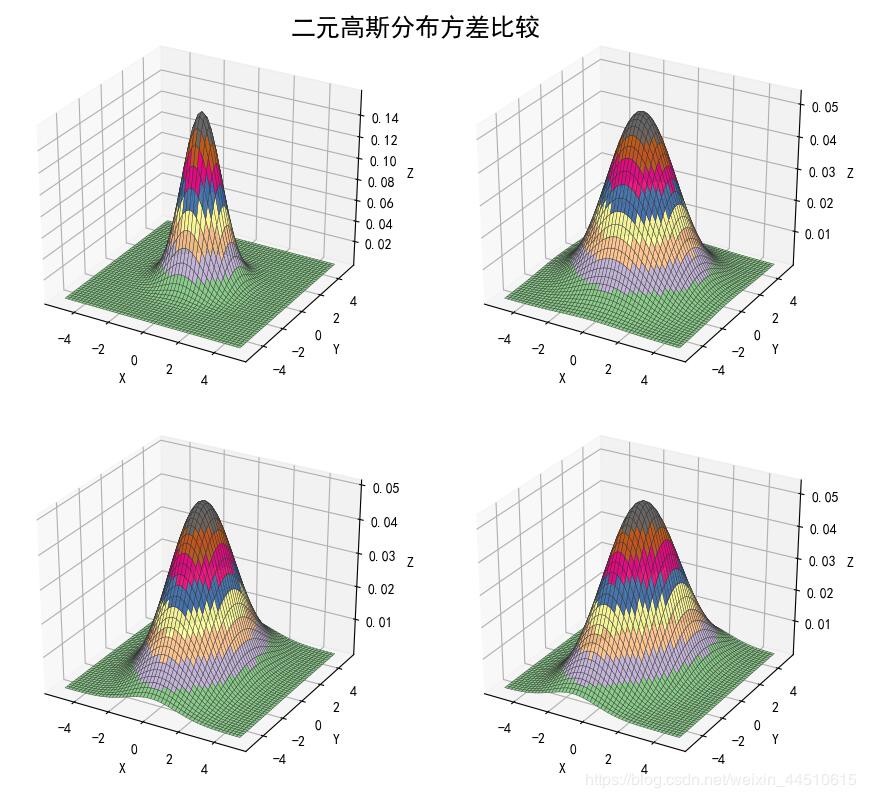使用python模拟高斯分布例子
正态分布(Normal distribution),也称“常态分布”,又名高斯分布(Gaussian distribution)
正态曲线呈钟型,两头低,中间高,左右对称因其曲线呈钟形,因此人们又经常称之为钟形曲线。
若随机变量X服从一个数学期望为μ、方差为σ^2的正态分布。其概率密度函数为正态分布的期望值μ决定了其位置,其标准差σ决定了分布的幅度。当μ = 0,σ = 1时的正态分布是标准正态分布。
用python 模拟
#!/usr/bin/python
# -*- coding:utf-8 -*-
import numpy as np
from scipy import stats
import math
import matplotlib as mpl
import matplotlib.pyplot as plt
from mpl_toolkits.mplot3d import Axes3D
from matplotlib import cm
import seaborn
def calc_statistics(x):
n = x.shape[0] # 样本个数
# 手动计算
m = 0
m2 = 0
m3 = 0
m4 = 0
for t in x:
m += t
m2 += t*t
m3 += t**3
m4 += t**4
m /= n
m2 /= n
m3 /= n
m4 /= n
mu = m
sigma = np.sqrt(m2 - mu*mu)
skew = (m3 - 3*mu*m2 + 2*mu**3) / sigma**3
kurtosis = (m4 - 4*mu*m3 + 6*mu*mu*m2 - 4*mu**3*mu + mu**4) / sigma**4 - 3
print('手动计算均值、标准差、偏度、峰度:', mu, sigma, skew, kurtosis)
# 使用系统函数验证
mu = np.mean(x, axis=0)
sigma = np.std(x, axis=0)
skew = stats.skew(x)
kurtosis = stats.kurtosis(x)
return mu, sigma, skew, kurtosis
if __name__ == '__main__':
d = np.random.randn(10000)
print(d)
print(d.shape)
mu, sigma, skew, kurtosis = calc_statistics(d)
print('函数库计算均值、标准差、偏度、峰度:', mu, sigma, skew, kurtosis)
# 一维直方图
mpl.rcParams['font.sans-serif'] = 'SimHei'
mpl.rcParams['axes.unicode_minus'] = False
plt.figure(num=1, facecolor='w')
y1, x1, dummy = plt.hist(d, bins=30, normed=True, color='g', alpha=0.75, edgecolor='k', lw=0.5)
t = np.arange(x1.min(), x1.max(), 0.05)
y = np.exp(-t**2 / 2) / math.sqrt(2*math.pi)
plt.plot(t, y, 'r-', lw=2)
plt.title('高斯分布,样本个数:%d' % d.shape[0])
plt.grid(b=True, ls=':', color='#404040')
# plt.show()
d = np.random.randn(100000, 2)
mu, sigma, skew, kurtosis = calc_statistics(d)
print('函数库计算均值、标准差、偏度、峰度:', mu, sigma, skew, kurtosis)
# 二维图像
N = 30
density, edges = np.histogramdd(d, bins=[N, N])
print('样本总数:', np.sum(density))
density /= density.max()
x = y = np.arange(N)
print('x = ', x)
print('y = ', y)
t = np.meshgrid(x, y)
print(t)
fig = plt.figure(facecolor='w')
ax = fig.add_subplot(111, projection='3d')
# ax.scatter(t[0], t[1], density, c='r', s=50*density, marker='o', depthshade=True, edgecolor='k')
ax.plot_surface(t[0], t[1], density, cmap=cm.Accent, rstride=1, cstride=1, alpha=0.9, lw=0.75, edgecolor='k')
ax.set_xlabel('X')
ax.set_ylabel('Y')
ax.set_zlabel('Z')
plt.title('二元高斯分布,样本个数:%d' % d.shape[0], fontsize=15)
plt.tight_layout(0.1)
plt.show()


来个6的
二元高斯分布方差比较
#!/usr/bin/python
# -*- coding:utf-8 -*-
import numpy as np
from scipy import stats
import matplotlib as mpl
import matplotlib.pyplot as plt
from mpl_toolkits.mplot3d import Axes3D
from matplotlib import cm
if __name__ == '__main__':
x1, x2 = np.mgrid[-5:5:51j, -5:5:51j]
x = np.stack((x1, x2), axis=2)
print('x1 = \n', x1)
print('x2 = \n', x2)
print('x = \n', x)
mpl.rcParams['axes.unicode_minus'] = False
mpl.rcParams['font.sans-serif'] = 'SimHei'
plt.figure(figsize=(9, 8), facecolor='w')
sigma = (np.identity(2), np.diag((3,3)), np.diag((2,5)), np.array(((2,1), (1,5))))
for i in np.arange(4):
ax = plt.subplot(2, 2, i+1, projection='3d')
norm = stats.multivariate_normal((0, 0), sigma[i])
y = norm.pdf(x)
ax.plot_surface(x1, x2, y, cmap=cm.Accent, rstride=1, cstride=1, alpha=0.9, lw=0.3, edgecolor='#303030')
ax.set_xlabel('X')
ax.set_ylabel('Y')
ax.set_zlabel('Z')
plt.suptitle('二元高斯分布方差比较', fontsize=18)
plt.tight_layout(1.5)
plt.show()

图像好看吗?
以上这篇使用python模拟高斯分布例子就是小编分享给大家的全部内容了,希望能给大家一个参考,也希望大家多多支持我们。
赞 (0)

